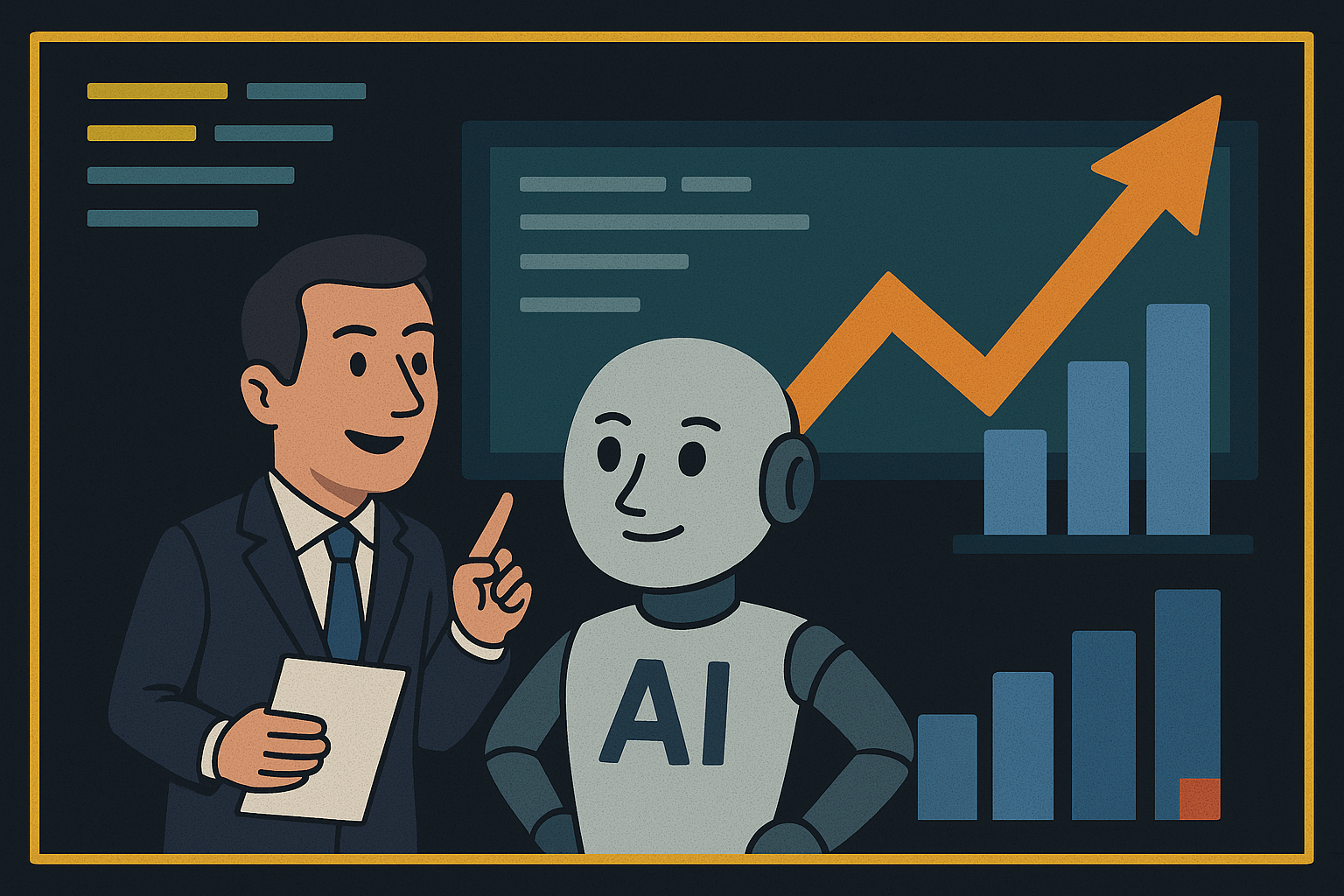The 2-Month AI Transformation: How Private Equity Firms Drive Immediate EBITDA Impact (Amrit Saxena)
The 2-Month AI Transformation: How Private Equity Firms Drive Immediate EBITDA Impact
Why successful AI transformations focus on quick wins first, not moonshot projects
"We like to come into a business and deliver demonstrable EBITDA uplift within two months of getting started. That includes the diligence and early analysis, and building and deploying the first system that is directly driving some demonstrable EBITDA enterprise value uplift."
That's not a promise from a consultant trying to land a deal. That's the operating principle of Amrit Saxena, founder and CEO of SaxeCap, who has led AI transformations for over 100 companies and created billions in enterprise value for private equity firms.
In our Just Curious interview, Amrit revealed exactly how his team consistently delivers measurable AI impact in 60 days or less—and why this approach works where others fail.
The Problem: AI Transformation Theater
Most AI initiatives fail not because the technology doesn't work, but because they're solving the wrong problem—whether you're a business leader implementing AI internally or a private equity investor driving transformation across portfolio companies.
"One of the common failure patterns we observe is there will be a board directive to go and implement AI at a business," Amrit explains. "And then the team will go and ideate different ways to leverage AI... but not enough thought is actually put into what are you solving for."
The result? AI projects that increase costs, consume resources, and deliver vague benefits that can't be measured. Companies and their PE backers end up "solving for the board directive that you need to have AI in place" rather than solving actual business problems.
Amrit's insight: "AI is just another arrow in your quiver. It's just another tool in your toolkit. What businesses should really do is figure out what is the enterprise value creation that I'm seeking to drive?"
The SaxeCap Methodology: From Diagnostic to Deployment
Having transformed companies worth $100 million to tens of billions, Amrit's team has developed a systematic approach that consistently delivers results.
Phase 1: The Rapid Diagnostic (Week 1-2)
- The process: Survey all major workflows, data assets, and financial systems to identify AI opportunities.
- The output: 30-50 discrete opportunities that are "deterministically feasible near term."
- The key insight: "We then go and shortlist down to what are the top 5 to 10 that will be the most accretive to enterprise value near term that are relatively low risk to execute."
- Why this works: Instead of chasing impressive-sounding AI projects, you focus on high-impact, low-risk initiatives that can deliver immediate value—whether you're optimizing your own operations or driving EBITDA improvements across portfolio companies.
Phase 2: Build & Deploy Solutions (Week 3-6)
- The approach: Forward deploy a team of 50+ engineers and data scientists to build production-ready systems.
- The deliverable: Not a proof of concept, but "robust, deployable, extensible software" that creates immediate EBITDA impact.
- The support model: SaxeCap doesn't just build software—they handle training, change management, and ongoing maintenance for companies without technical teams.
Phase 3: Sustainable Integration (Week 7-8)
- For companies with tech teams: Hand over codebase, provide training, remain available for future support.
- For companies without tech teams: Continue to support and maintain solutions on an ongoing basis.
- For PE investors: This dual approach ensures portfolio companies can sustain AI value creation regardless of their internal technical capabilities.
- The key principle: "What we deliver is not just a POC or some piece of software that you then have to figure out how to maintain... we deliver end-to-end creating that value creation in a way that's sustainable."
Real-World Example: The Preschool Labor Optimization
Amrit shared a compelling example from a private equity-backed education platform with over 100 preschool sites.
The Problem: The business had grown through acquisitions, creating disparate data systems. When leadership wanted to know which sites were overstaffed, it required "pulling data from a bunch of different systems, then do analysis in Excel, take us a few hours."
Why this mattered: "In the preschool industry, really the only real variable cost is your labor. So if you tightly manage your labor, you have a high margin business. If you don't, you have a middling margin business at best."
The Solution: SaxeCap deployed their labor optimization platform:
- Integrated dozens of discrete data systems
- Built machine learning models to predict student attendance by hour and age level
- Created optimization algorithms that maximize site-level EBITDA while meeting government requirements
The Results:
- Labor productivity increased over 50%
- EBITDA margins increased by over a third
- No generative AI required—"This was all feasible before Transformers came out"
The Value Creation Breakdown
Across SaxeCap's 300+ deployed AI systems, the value creation typically breaks down as:
60% Cost Reduction/Operating Leverage:
- Process improvement and automation
- Human capital augmentation
- More scalable cost structures
40% Revenue Expansion:
- New AI-first products and services
- Data-driven cross-selling and upselling
- Reduced customer churn
The range: From 10% EBITDA margin expansion on the low end to 4X EBITDA improvement in exceptional cases.
The Generative AI Opportunity
While traditional AI and machine learning drive most value today, generative AI opens new possibilities for knowledge work automation.
- Example: A healthcare services company where SaxeCap automated insurance eligibility verification:
- The manual process: Teams read unstructured doctor's notes, cross-reference with insurance plans, and answer 20 questions per patient to determine eligibility.
- The AI solution: Generative AI systems that can "feed in that same corpus of text and spit out the same results that a human would process."
- The impact: "Teams of dozens or even hundreds of people doing this kind of work that you can then almost completely automate."
Three Critical Questions for Any AI Initiative
Before starting any AI transformation—whether you're a business leader or PE investor evaluating opportunities—Amrit asks these questions:
1. Business Model Compatibility
"Walk us deeply through your business model and really understand your revenue model and how much of it is project-based or value-based versus time and materials or cost plus."
Why this matters: If you're charging time and materials for work you then automate, you cannibalize your own revenue.
2. Workflow Analysis
"Walk through all the most human capital intensive job families at the business and actually walk through what the major workflows are and how much automation is already in place."
The insight: The biggest opportunities often lie in the most manual, repetitive processes.
3. Current AI Readiness
"What does the team look like? What have they done? What do they plan to do? If they could wave a magic wand, what would they love to do?"
The goal: Understand both current capabilities and aspirational goals to design the right transformation path.
Why Speed Matters More Than Perfection
Amrit's emphasis on 60-day delivery isn't arbitrary—it's strategic.
"People have been burned by AI time and time again," he explains. "AI is not a new concept. It's been around since the sixties. There's been a lot of hype in the industry and there have been a lot of companies that have promised a lot and not delivered."
The psychology: "To build trust, to build the momentum with management teams and get them to really believe that you can actually go and effectuate real value creation with AI, it is imperative to hit the ground running."
For PE investors: Quick wins demonstrate ROI to LPs and build confidence for larger AI investments across the portfolio.
The strategy: "Crawl, walk, run, but deliver value very quickly with initiatives that are deterministically feasible that will deterministically drive value."
The Competitive Advantage
In a world where everyone has access to the same foundation models, where does sustainable value come from?
Amrit's framework:
- Proprietary data assets that enable differentiated AI capabilities
- Customer penetration and distribution that creates switching costs
- Execution excellence in bringing AI-driven innovations to market
"It's become a lot easier to innovate with generative AI... So I don't want to overstate it and say that every business can build a moat with AI. I think it's case by case."
The Bottom Line
The companies winning with AI aren't necessarily the ones with the most sophisticated technology. They're the ones that:
- Focus on solving real business problems, not implementing AI for its own sake
- Prioritize quick wins that build momentum for larger initiatives
- Deliver measurable EBITDA impact within 60 days
- Build sustainable systems that continue creating value long-term
As Amrit puts it: "Figure out what is the enterprise value creation that I'm seeking to drive? What is the business problem that I'm seeking to solve? And can AI be a useful solution in the pursuit of that?"
The question isn't whether your business—or your portfolio companies—can benefit from AI. It's whether you can move fast enough to capture that value before your competitors do.
Want more insights on AI transformation and private equity? Read the full interview with Amrit Saxena for deeper insights into his approach to AI-driven value creation.
Stuart Willson is the founder of Just Curious, a platform dedicated to helping SMB leaders and private equity investors practically adopt AI to enhance growth, margins, and efficiency.
Founder of Just Curious, a platform dedicated to helping SMB leaders practically adopt AI to enhance growth, margins, and efficiency.
.svg)



.svg)
.svg)
.svg)
.svg)

.svg)

